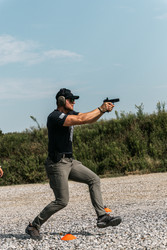Forming A Good Handgun Grip
Posted by Tulster on Dec 10th 2024
A firm and consistent grip directly impacts your shooting performance. It minimizes recoil, reduces muzzle flip, and ensures faster follow-up shots. Here are some of the basic need-to-know habits that you should train.
CHOOSE THE RIGHT HANDGUN
Before diving into technique, make sure your handgun fits your hands comfortably. The right fit allows you to access the trigger while maintaining a firm hold naturally. Look for a handgun with a grip that matches your hand size. Some firearms have customizable backstraps or grips to fit different hand shapes.
TWO-HANDED GRIP TECHNIQUE
The two-handed grip, known as the thumbs-forward grip, is widely recognized for stability and control. Here's how to do it:
- Dominant Hand Placement: Wrap your dominant hand around the grip, ensuring the web between your thumb and index finger is high and tight against the backstrap.
- Trigger Finger Placement: Rest your trigger finger along the frame, outside the trigger guard, until you're ready to shoot.
- Support Hand Placement: Position your support hand so that it fills the space on the grip. Your fingers should wrap around the bottom three fingers of your dominant hand.
- Thumbs Forward: Align both thumbs along the frame of the gun, pointing forward toward the target.
- Focus on Pressure and Stability: Most of your grip strength should come from your guide hand. By wrapping your guide hand around your dominant hand, you will form a c-clamp around the pistol grip. This provides the most stable shooting mechanics possible.
TRAIN YOUR GRIP
Dry firing (practicing without live ammunition) is an excellent way to build muscle memory. To ensure safety while practicing, use snap caps or dummy rounds. Consistency is key to developing a reliable grip. Dry fire will help you avoid switching grip styles too frequently and stick to one technique until it becomes muscle memory.









